@yyzsantabarbara Where does Mitch's DSP insert into my system? I'm using one of either of two preamps: a late 80's/early 90's Mcintosh C35 or an '80's Conrad Johnson PV5.
Typically, I'll have 2-3 analog inputs into the preamp (CD player, DAC, and tube phono stage into C35 or will use built in phono stage when using PV5). Both have processor loops where something could be inserted into the signal chain to work on all inputs, but for Mitch's solution, would this have to be a computer?
|
@rooze My room is a dedicated room for me, so there’s some flexibility in room treatments -within reason because I still don’t want it to look too wacky. But it also doubles as an Atmos HT room and 2-ch audio room. Because of the way my side and ceiling Atmos speakers are placed, it’s hard to move my listening position by too much without getting me out of the ideal spot for Atmos.
I’m using cheap acoustic panels in the corners (not true bass traps) and have some I can use on the side walls, but looking at REW measurements with and without, I’m not sure they’re doing much.
But I can definitely take more REW measurements with the mic in different places to see if that bass dip does smooth out. It can either give me some incentive to try to find a way to move the LP, or resign myself to the fact that it’s not easily fixed without a sub or room correction.
I do have a SVS sub I use for the Atmos system. With some switch boxes (I have two Schiit Sys devices), I can double up the use of that sub for both Atmos and 2-ch (I know it’s not an ideal sub for audio though).
While I’m using all vintage equipment for my 2-ch setup, both preamps I use (Mcintosh C35 and Conrad Johnson PV5) have processor loop options for a hardware DSP solution.
One thing that would seem to work is the miniDSP Flex device which uses Dirac Live. It’s about $750 (I guess $800-825 with tax/shipping) and I believe you can only selectively treat the frequency ranges you want.
On one hand, it’s not a cheap solution, but bass traps from places like GIK can run $400-500 each too, so I could easily spend as much or more than that on acoustic room treatments.
|
Just wanted to update the thread about the results of playing with the listening position based on suggestions from forum members (on another forum).
The suggestion was to follow the rule of odds in speaker and LP placement. This resulted in putting my speakers with front baffles 37" from the front wall (1/5), 28" from side walls (1/5), which placed them roughly 80" apart.
The original suggestion was to have my listening position (LP) 5'/60" from the rear wall. I took a FR measurement there. But this LP moved me pretty far forward from my Atmos centered LP, so I took some additional measurements moving further back toward the back of the room in ~6" increments.

If we zero in on the 55-60Hz dip as a reference point:
The blue (lowest trough) is the 60" off back wall LP
Next higher green line is 52"
Next two higher lines (purple and bolded yellow) are ~46" (I tried to replicate this with a second measurement later, was probably an inch or two off from original position, but it's close)
Highest brown/gold line is the near-original 40" off back wall LP (I think I originally started at 38")
My observation is that the LP doesn't much affect the 35Hz or 95-100Hz peaks - they're pretty much there and similar in magnitude regardless of LP within this range.
The 55-60Hz dip though is pretty heavily influenced by LP with it filling it more the further back the LP moves toward the back wall, but this comes at the expense of creating a new dip at ~180-190Hz, which isn't as deep as the 55-60Hz one, but it's definitely a trade-off.
Based purely on this comparative FR curve, I think I like the bolded 46" off the back wall response the best. It fills in the 55-60Hz dip to within -3dB and keeps the 180-190Hz dip it creates to within -3dB as well.
So if I stick with this, I just live with the -3dB dips and experiment to see if there's anything in the way of reasonably priced room treatments to reduce the 35Hz and 95-100Hz peaks.
Does this seem like the best compromise and an overall "good enough" room environment to not have to spend money on expensive room treatments or digital room correction?
|
Yes, I'm kind of leaning against considering that the room seems "good enough" now that I've tweaked listening and speaker position.
To do a MiniDSP w/DIRAC Live experiment would be $500 minimum and to do a more sophisticated custom filter would require inserting a computer into my setup to run the more sophisticated DSP - that's $1000 minimum. Either of which would add an ADC/DAC step.
|
@yyzsantabarbara Thanks for the explanation. I wrote to Mitch and we exchanged a couple of emails.
He referred me to a device that could be inserted into a processor loop and interface with a computer to make it work on all sources, though it was an open question on whether the device would play well with my particular process loop (impedance matching and all).
It would be an over $1100 solution for everything which could be worth it if there were no other ways to address my issues.
But I do think my room is shaping up to be okay after all. And Mitch said if I changed my speakers (which is always possible), the filters would need to be redone, so I need to be sure I’m both settled on my endgame speakers and have remaining issues that keep me from being happy with the sound without DSP.
It’ll take me some time to sort all that out.
|
@erik_squires
Thank you, I’ll try the AM Acoustics version.
If I wanted to take time based plots, is that doable using reasonably priced tools, or is that a pro assessment job?
I did move my speakers to the 1/5 position from front and side walls, and LP to 1/3 position from back wall. Seems to have helped some. I’ll post the resulting curves soon.
I do have acoustic panels that I think could work for the mid/high frequencies. Had no idea the FR curve and REW program was incapable of picking those up.
Do you have to spend big $ on something like GIK bass traps, or is there a more cost effective option vs spending $500 per bass trap - that can add up quickly!
Also, off topic, I had tried to send you a private message to ask about speakers as you had commented a fair amount on a particular brand and I wanted to ask your opinion on some things. But I got a weird message about a moderator having to approve my message - not sure it was ever received by you. Just sent another message now to try again.
|
Here's the freq response curve with my listening position about 5ft/60" into the room, which is at the 1/3 point. Speaker baffles are at 37" from front wall (1/5) and 28" from side wall (1/5).
No toe-in currently.

1/3 smoothing, normalized to 75dB at 1kHz.
If I use +/-3dB as a criterial, there are those two peaks at 35Hz and 95Hz, big dip at 58Hz. Not sure how badly these big peaks are potentially degrading the sound. Besides that, a 4dB peak around 650-900Hz, but the rest of the FR curve is within +/-3dB.
This is sitting further toward the back wall at 51" instead of 60".

The 55-60Hz dip is reduced some, but overall it seems a little less smooth than the 60" FR esp from 200-600Hz. Subjectively, it seemed to me that 51" was a little clearer, but the vocals a little less warm. Not sure if that's consistent with what you'd expect from the FR curves.
Here are the two superimposed on each other. . .

On another forum, some members thought it this was workable and I could just go with this based on where the peaks/dips were, with 60" being optimal.
Finally, here's even further back at 45" (compared against 60" as a benchmark):

Here, the 35Hz peak is increased, the 58Hz dip is pretty dramatically flattened out, but the tradeoff is a dip created at 180Hz.
|
@erik_squires Thanks for spending the time to thoroughly explain those issues. I can easily turn off smoothing, but at some point, the curves get so crazily jagged (with no smoothing), that I'm not sure what I'm supposed to take from it.
I haven't figured out how to turn off gating yet. Trying to research that now.
@lemonhaze Thanks for your input. When you say "some absorption", do you mean bass traps? If so, are there more economical solutions than the $500/bass trap solutions from GIK?
Yes, with minimal treatment of the room, there's a definite tradeoff between dips at 58Hz and 180Hz. If I move my LP so the 58Hz dip fills in a lot, it creates a smaller dip at 180Hz. You can see that 5 posts above in the 60" LP vs 45" LP.
I do see that 35Hz peak in the many of the plots posted by other people in different rooms, so that one seems common. The other ones seem more variable and a matter of trade offs.
In a room my size and filled up with record, CD, and gear cabinets as much as it is, I think it's honestly unrealistic to entertain getting two new non-ported subs. I understand there's a proper way to do things, but I think the question for me is what gets me close enough or good enough to live with while still keeping my room as usable as possible.
Because if getting things closer to ideal requires my stepping around subs or having to contort to access my media because a sub is blocking clear access to a rack, then it's going to be a daily irritation. Not sure I mentioned above, but this room is also a TV room with Atmos in-wall/in-ceiling speakers, so I'm admittedly trying to do a lot with the room and one of the consequences of that may be I'm not going to be able to do things as ideally as a pure 2-ch listening room.
I do have a single HT sub (SVS 10" ported sub) and I could dual purpose that if it would help. It does have a phase dial. Since I'm using older gear, I'm going to need to sum my stereo signal to mono and then route it to my sub (no speaker level inputs on my sub, just a single RCA). I could play around with that and if I see the potential, maybe I start to think about how to move some things out of the room and consider a couple of ported subs.
But the room just isn't all that big to begin with unfortunately.
All that being said, I am open to room treatments, preferably beginning with ones that are highest bang-for-buck and seeing how much that improves things before going too far down the rabbit hole and diminishing returns.
|
@lemonhaze Here's an alternate FR curve at 48" (bolded line) vs 60" (which was what was previously recommended to me as best of my alternatives).
48" reduces the 60Hz -11.5dB dip to -4.5dB, but the 180Hz dip is increased from -1dB to -3dB, a 300Hz +3dB peak is created, and 550Hz goes from +3dB to +5dB.
Overall, 48" seems a little more peaky, but the benefit is filling in that 60Hz trough pretty substantially.

|
@kofibaffour while the front baffles are 37” from the front wall, I have cabinets in the front that gear is set on/in. So there’s very little space between cabinet front and speaker back as seen in pic.
This means I can only open one side of cabinet without moving the speaker, which I’m okay with as I don’t have frequently used items in there.
But it’s pretty much a non-starter to move these cabinets off the front wall as there’s no other place to put them in the room and I need the storage space.
|
Question for the group here. I tried, just for learning purposes, to use my SVS sub to see if it would help fill in that 60Hz dip. Here’s the FR curve. While it did fill in the 60Hz dip, it blew up the 35Hz peak more.

The phase is set to 90 degrees on a variable dial that goes 0 to 180. My question: would playing with phase at all help this curve?
And a more general question, what is causing this 60Hz dip? Cancellation of sound waves at 60Hz, right? Theoretically, if I put big bass traps in the back corners of the room, does that solve this issue as well as potentially the 35Hz and 100Hz peaks? Or is it not that simple?
|
The issue is I have very limited adjustments on my sub. See pic below:

So I can adjust phase and level, but nothing else.
I was also having some issues getting REW to output to mains and sub at the same time. So when I played with phase using sub output only, it didn’t change anything because I think it’s the phase interaction with the mains that will cause different responses to the FR curve. Just changing phase if the sub is the only thing playing the frequency does nothing to change the FR curve.
|
The 35Hz spike is there regardless of speaker placement and LP - varies a tiny bit in magnitude, but not much. Room is 11.5’ wide by 15.5’ long and 8’ high. Probably a characteristic of the room.
The 60Hz dip can be filled in at the expense of creating a more shallow one around 180Hz.
The speakers are places 1/5 of the room length from the front wall and 1/5 of room width from the side walls. It was recommended to place the LP about 1/3 room length from back wall (60”), but I found I preferred my LP 54” from the back wall.
No tone controls active. I’m using Pure Direct mode on my AVR to bypass the Audessey room correction. I’m only using the AVR for the sweeps because it can accept the HDMI from my MacBook. Normally, I use a McIntosh C35 preamp that has a 5-band EQ, but I normally listen flat. Sometimes with a small bit of loudness contour, but mostly flat.
|
Sorry for the possible distortion in the pics. They’re 1.33:1 aspect ratio and I’ve tried to plug in the numbers to preserve the right proportions, but it posts them distorted once I actually post and view in portrait mode on my phone. When I turn my phone into landscape mode, the pics look like right and undistorted.
|
Ok, I need to add one more important thing. In the past couple of days, I’ve decided to at least try bookshelf speakers in place of the Monitor Audio Gold 20’s.
Part of this is because I am wondering if the Monitors are still too big for the room and the bass output qty is still too much. And part of this is just me being curious about whether bookshelf speakers can satisfy me as main speakers - I’ve been resistant to this in the past because I’ve always seen bookshelf speakers as “too small”.
But the reality is my room and free volume in this room is also small, so a bookshelf may be the most appropriate sized speaker for my situation.
While it’s by no means a given I’ll like the bookshelves and that they’ll become my main speakers over the Monitors, it’s very possible. I anticipate the FR curve and overall interaction between a different speaker and my room will be different as well so wanted to give the thread a heads up so I’m not exercising people to help me find a solution for a problem that may possibly change.
|
I’ve posted pics of my room in other threads w.r.t. other questions/topics, but it might be helpful to show what I’m dealing with here.
Front of room:
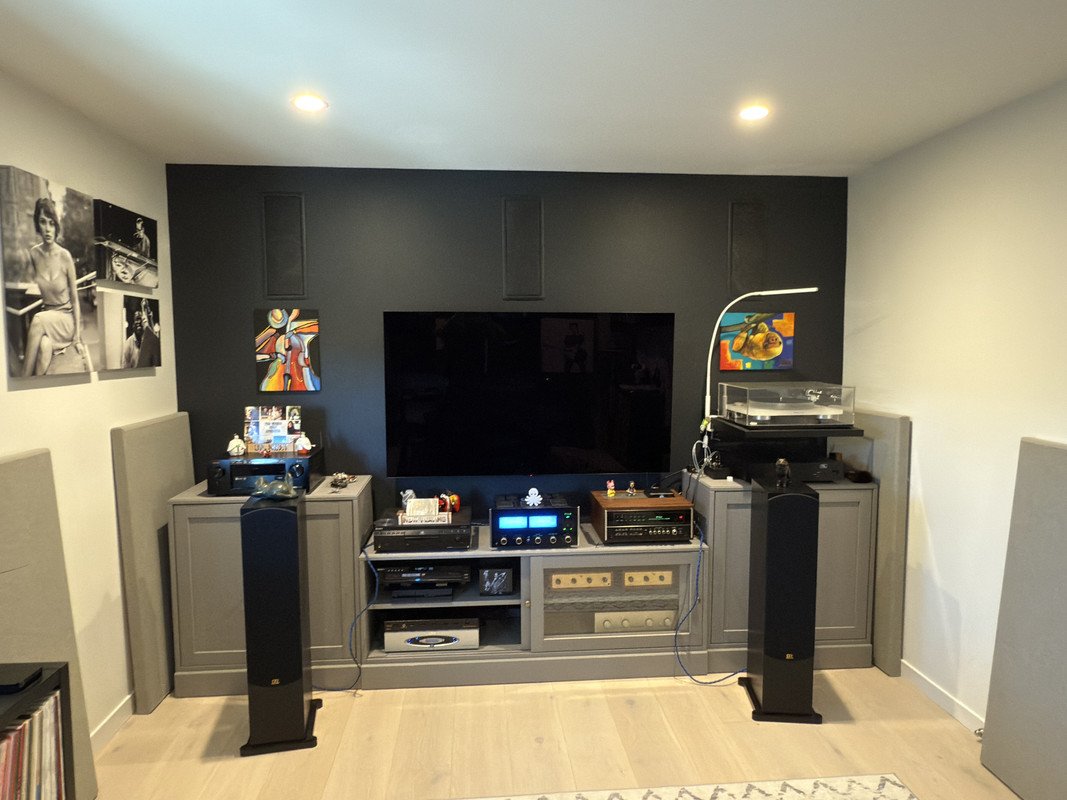
Right side of room with entry door in middle of wall:
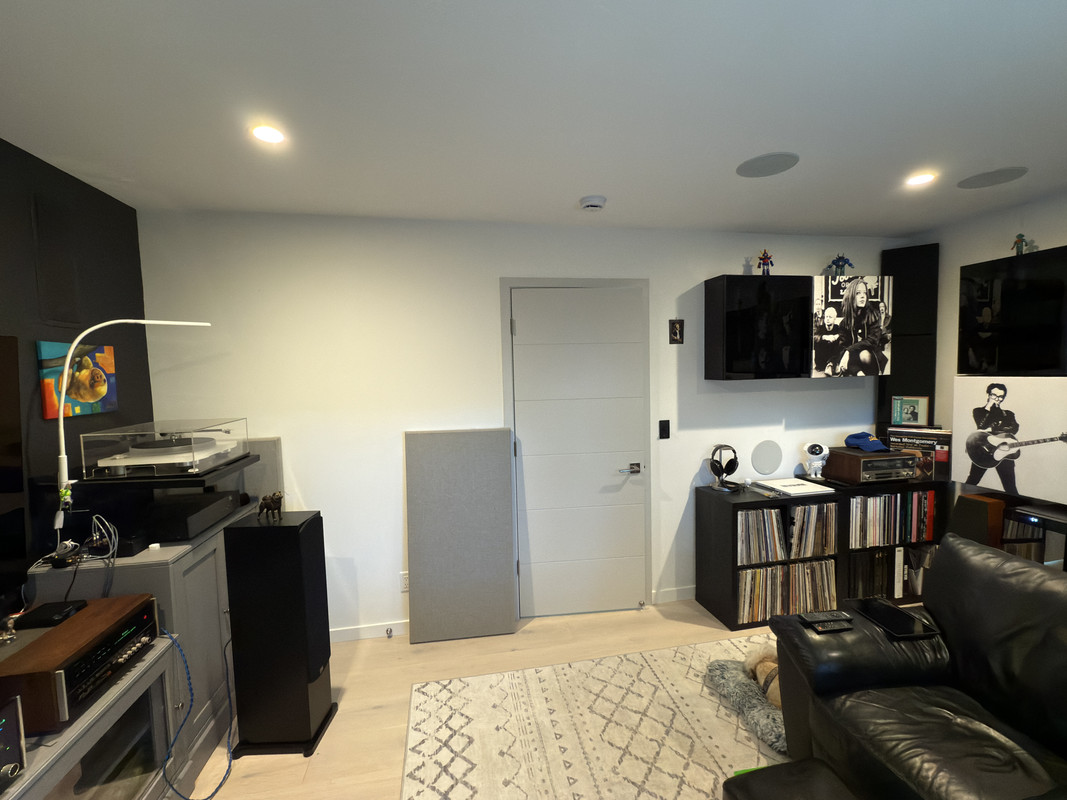
Back of room:
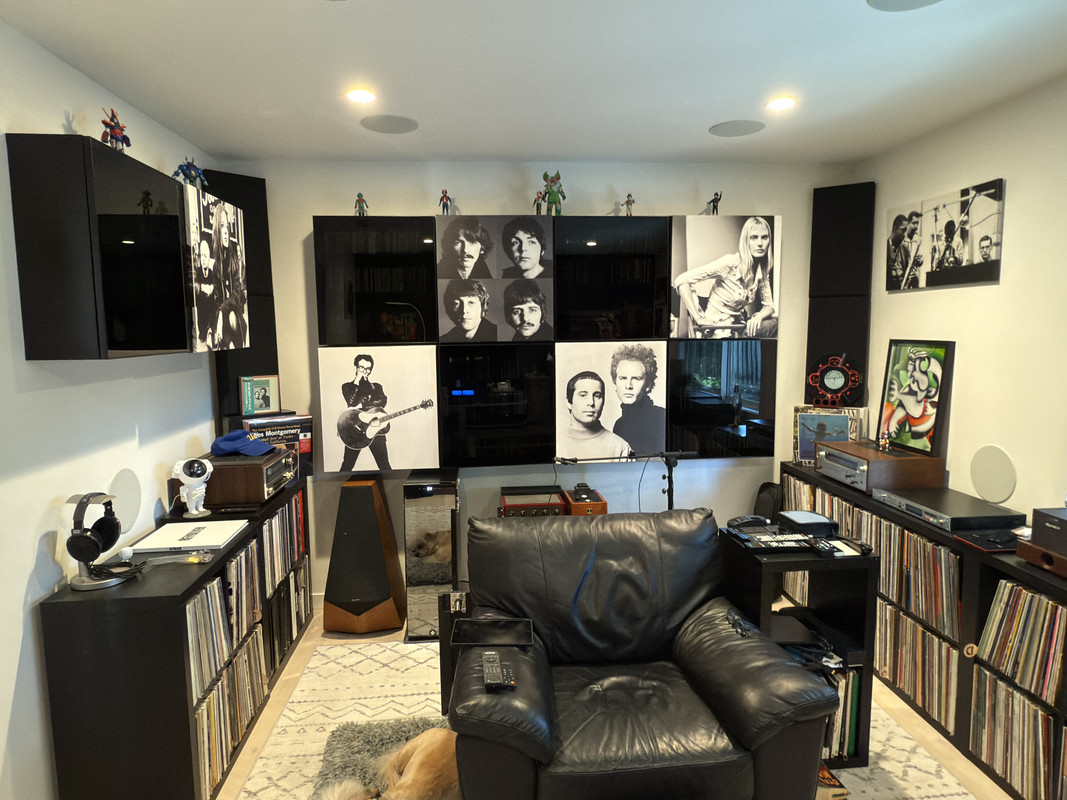
Left side of room:
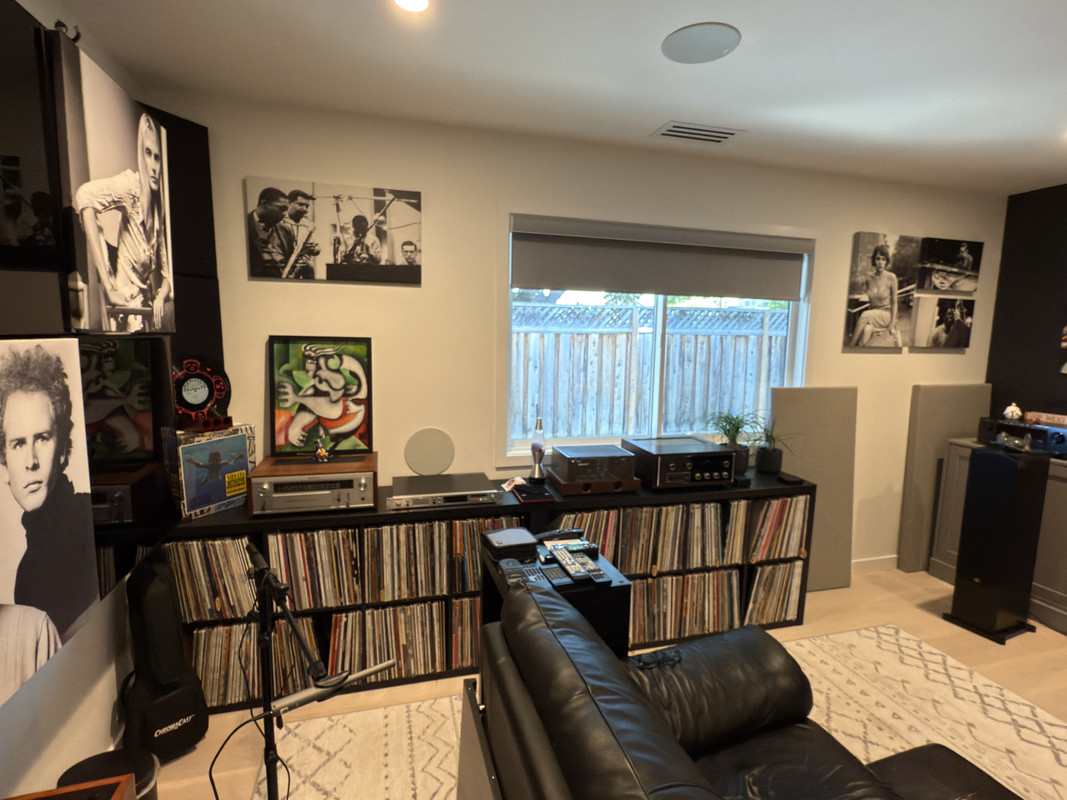
I can remove things like the single speaker in the back, the beverage fridge, as well as the “side table” to the left of the chair. But all the record racks and wall cabinets for CDs are my media storage and have to remain in the room. The front cabinets both hold gear (active and spare) and I really prefer not to replace them.
So it’s a crowded room filled with “stuff”. The sub is currently within 6” of the back wall firing toward the left wall is the room with records in rack about 42” away. The speaker front baffles are about 3ft from the front wall and near the cabinets, which prevents the inside doors from swinging open without moving the speakers. Which is fine, I can deal with that.
But my options for placing a sub are limited to the remaining periphery of the room, which means to the right of the record rack on the left wall near the window, anywhere on the back wall, or I could use it as a side table in place of the 1x2 cubby I’m currently using as a side table. I suppose also on the front of the room between the main speakers as well.
I’m already somewhat having to step around things in certain places to access the records. I’d prefer not to place the sub somewhere in the middle of the room and have something else to step around.
So this is what I’m working with. No complaints as I’m trying to do a lot with this room and the agreement with my wife was to store all my media and audio gear in my room to avoid clutter in the rest of the house.
But there are somewhat limited options left for placing the existing sub or adding a second one.
|
@lemonhaze Great suggestions, thanks so much!
I’m assuming modest sized sealed subs would do for a room like mine. I see REL subs favored by a lot of audio people. Is this what you’d recommend?
Whay type of fill do you use for your triangular traps? And you’re saying build it horizontally and put it above my wall cabinets across the entire back wall at the interface between wall and ceiling? And you’d go as thick as I could go, up to and including 6” if I can swing it?
|
@mswale I think if I wanted to move my sub around to cancel the nulls, which I think is a good idea and ideal, I’d want to get a smaller sub. The SVS was from my old HT system in a bigger space, and while no problem to reuse for HT in my new smaller space since the AVR will use Audessey to adjust level, it’s not an ideal sub for music.
I don’t notice the dip or that anything is lacking, but it’s probably one of those things where you don’t know until you hear the alternative.
But as mentioned above, I’m going to try bookshelf speakers first before getting a new sub or committing to room treatments or digital room correction. The Monitor Audios that I’m using now are spec’d down to 30Hz. The new bookshelf speakers are spec’d down to 38Hz. So they’re bound to create less of a 35Hz peak if they’re already down 5db or more at that frequency. At least I think.
When I measured my friend’s Electa Amator II’s, which are spec’d at 35Hz or so, there was still a peak, but much lower in magnitude. I’m sure I’ll still have the 60Hz dip and 180Hz dip tradeoff to some extent, but the overall balance of the FR curve may give me more speaker placement and LP options to help me find a better balance.
@atp001 I’m curious about trying something like Dirac Live - the price for entry just comes at a hefty price tag and the input I’ve received from this and other forums is that it could help in some aspects, but can’t help in others. I think I’ll wait until measure and listen to my new bookshelves and see where I am after that.
It was suggested I try the trial period of Dirac Live, I just need to figure out which EQ software also has a trial period that will allow me to use it with their software and target curves. I haven’t had the time to do that yet.
|
Those SVS subs are pretty cool - compact, sealed, and not too expensive.
I can take some measurements with ports plugged on my current speakers, but I really want to see how the curves look with my incoming bookshelf speakers before deciding how big my issues are on a baseline level as well as how much they it can be improved by tweaking LP and speaker location.
Meanwhile, I’ll do some homework to figure out how to build those superchunk traps.
|
Update to the thread. Here are 3 FR curves for my new-to-me Fritz LS7 Illuminator bookshelf speakers:
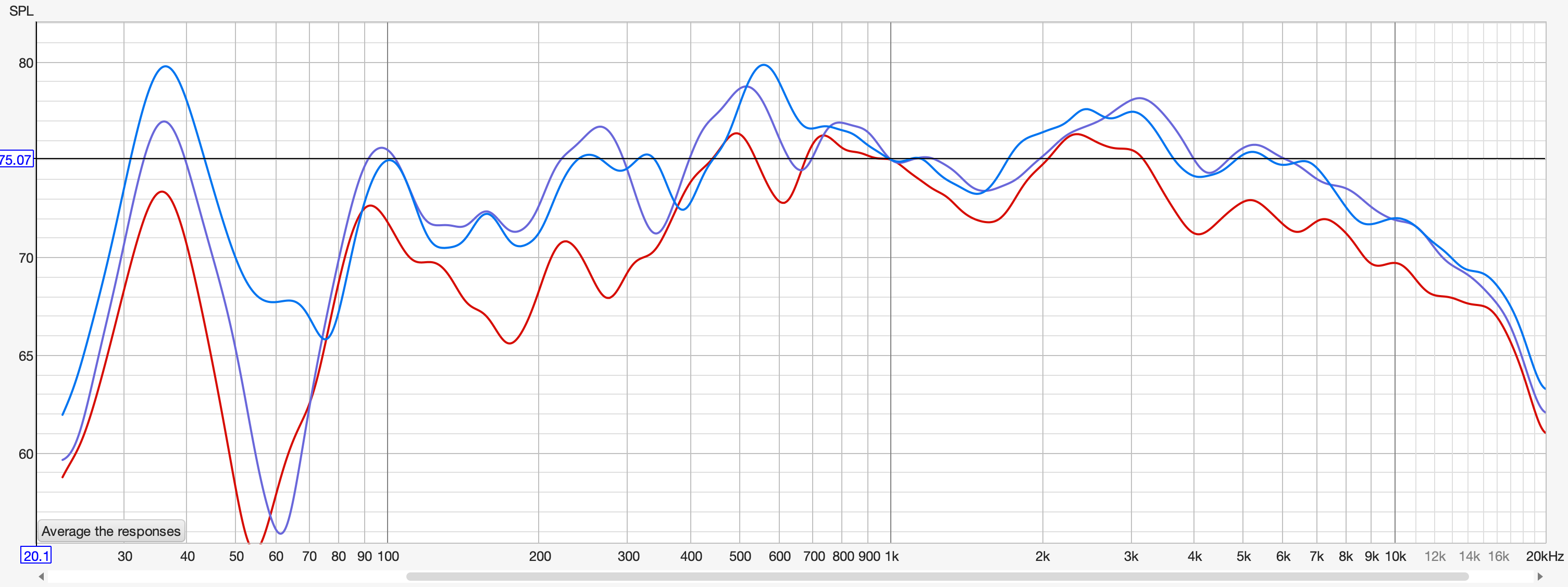
The difference in the curves are 3 different listening positions:
Red: 60" from back wall
Purple: 48" from back wall
Blue: 36" from back wall
The 35Hz peak isn't nearly as high as with the previous speakers (Monitor Audio Gold Reference 20) perhaps because the LS7's put out less quantities of bass vs the floor standing Monitors, but that 40-80Hz null is very much there and even in the "best" case at 36", it's down about 10dB from reference level. There's another dip around 100-250Hz or so.
As mentioned earlier, I'm very open to getting two audio-focused subs like the SVS SB-1000 Pro to fill in the nulls in the bass region if that will even out the bass response.
About the super chunk bass traps for the back wall - I measured and actually only have 12" between the top of the cabinets and the ceiling - not sure if a scaled down version of that makes sense there or is necessary with the new FR curves. I have about the same amount of room where the back wall meet the side walls, again constrained by the back cabinets.
Right now, I'm using big 26" high speakers as speaker stands, but will be getting 24" high real speaker stands tomorrow. I haven't tried to play with speaker location, they're still located 38" from the front wall and 28" from the side walls (at the 1/5 room width and depth location). Played with toe-in just a bit, but not a huge impact from what I could tell.
The ETC impulse peaks smoothed to 0.2ms show just one peak between 3-4ms around -14db or so, but all other peaks below -17dB.
Any thoughts are welcome as always.
As far as subjective listening impressions: They sound more forward in the upper mids/highs than the Monitors. At high volume, I want to tame them some. This is with grills off. With grills on, it seems to incrementally calm those forward frequencies some, but visually, I like the look without the grills much more, so will try to make adjustments as possible with grills off.
|
@kofibaffour So if the corner wedges are 12" x 12" x 17" (hypotenuse) and as long as needed to stretch from cabinet top to ceiling or on top of a cabinet between the ceiling and back wall - this size will still be beneficial?
FYI, it's actually further back into the room that reduces the major null. This 50-80Hz null is pretty much there with every speaker, but various in magnitude based on listening position. So it must be a room thing, as with the 35Hz peak.
|
Got a single SVS SB 1000 Pro and played with some of the settings. In conjunction with the variable loudness and 5 band EQ on my McIntosh C35 (I only tweaked one band), here’s my latest frequency response curve:
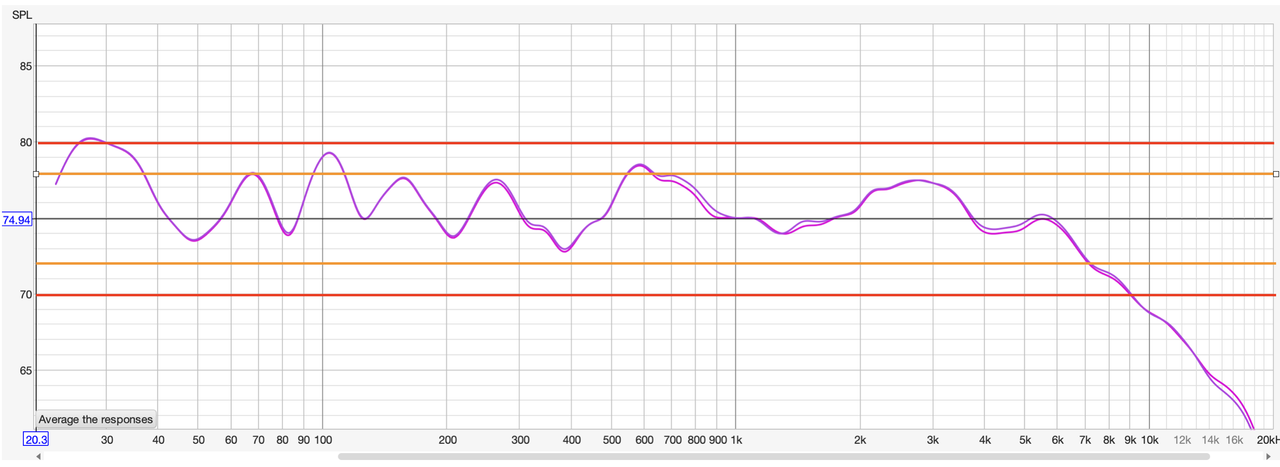
It’s zoomed in a fair amount so looks pretty lumpy, but the orange lines show the +/-3dB range and red lines the +/-5dB lines, so I’m mostly within 3dB except for the 100Hz and 575Hz peaks, ignoring the 28Hz peak as I think I can deal with that with the room compensation feature on the SVS and there’s likely little source material with musical info that low anyway (with my musical library).
So not bad at all. I’m not sure a second sub is really required, but am open to picking a second SVS up if I can find one for a good price.
|
@bugredmachine Your system seems to have a little extra energy from 1-6kHz - does it seem a bit bright to you?
|
@goose The floor is a suspended wood subfloor finished with engineered wood planks.
The speakers are on Monoprice Monolith 24” metal stands with the four columns filled with sand. There are spikes on the bottom of the stands sitting on protective discs to protect the wood floor from the spikes.
There are currently very thin pads on the top of the stands, but I’m about to put some thicker (but not objectively thick) silicone pads on top mostly to provide some light resistance to sliding if the speakers are bumped.
I think blu tack could mar the bottom finish, which is what I wasn’t planning on going that route and will likely do the silicone pads instead.
|
@goose That’s very interesting, thanks for bringing it up.
So many possible tweaks to try!
|
@goose Do the Isoacoustics solutions (ISO-155 or Aperta) fit within the realm of decoupling that you suggested, or are those not really what you meant?
|
@goose I just bought two packs of 4 and will try them out tomorrow!
|
@lemonhaze Thanks. It sounds good to me, filling in the lower parts of vocals quite noticeably so it goes from thinner/slightly nasal to more substantial and better balanced.
But here’s the thing: I’m having to set the SVS LPF all the way up to 200Hz. Because I’m trying to address the original 100-200Hz null from the mains:
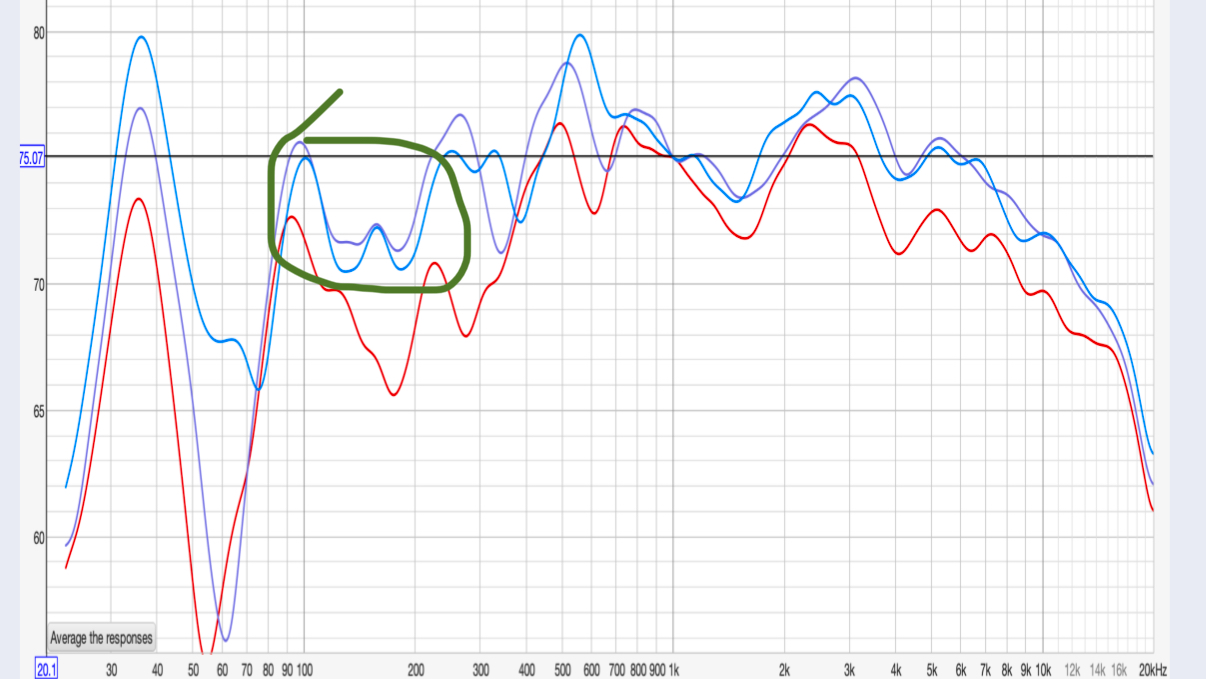
If I cut off where you would normally cut off with a sub, that null stays there.
Is it a total disaster that I have to overlap the sub and mains by that much to fill out the null, even if the final curves look pretty good?
|


















